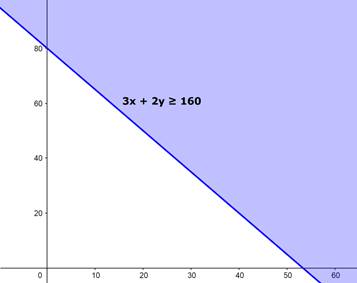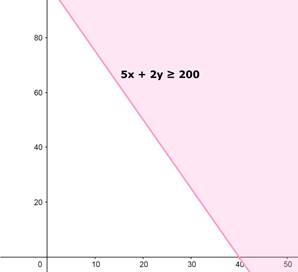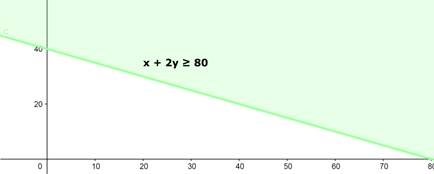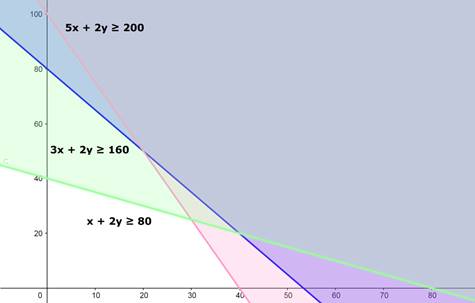The maximum value of Z = 4x + 3y subjected to the constraints 3x + 2y ≥ 160, 5x + 2y ≥ 200, x + 2y ≥ 80; x, y ≥ 0 is
Given object function is
Z = 4x+3y
Constraints are
3x + 2y ≥ 160
5x + 2y ≥ 200
x + 2y ≥ 80
x ≥ 0
y≥ 0.
Consider, the inequalities as equalities for some time,
3x + 2y = 160 ; 5x + 2y = 200 and x + 2y = 80
If we convert these into intercept line format equations, we get,
[Dividing the whole equation with the right hand side number of the equation]
![]() ;
; ![]() and
and ![]()
![]() ;
; ![]() and
and ![]()
From this form of line, we can say that the line 3x + 2y = 160 meets the x-axis at (![]() ,0) and y-axis at (0,80).
,0) and y-axis at (0,80).
This shows the inequality 3x + 2y ≥ 160 holds good in the below blue colored region.

Similarly, from the intercept line format, we can say that the line 5x + 2y = 200 meets the x-axis at (40,0) and y-axis at (0,100).
This shows the inequality 5x + 2y ≥ 200 holds above in the pink colored region.

Similarly from the intercept line format, we can say that the line x + 2y = 80 meets the x-axis at (80,0) and y-axis at (0,40).
This shows the inequality x + 2y ≥ 80 holds above in the green colored region.

Now considering the inequalities, x ≥ 0 and y ≥ 0, this clearly shows the region where both x and y are positive. This represents the 1st quadrant of the graph.
So, the solutions of the LPP are in the first quadrant where the inequalities meet.
Now by plotting all the graphs 3x + 2y ≥ 160 , 5x + 2y ≥ 200 and x + 2y ≥ 80 we get the below graph.

We can clearly see that, there is no area in the 1st quadrant where all the three inequalities met.
This clearly says that there is no solution for the LPP with the given constraints.
Hence the option D, is the solution to the problem.